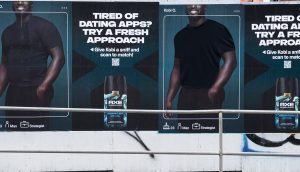You’d be hard-pressed to miss Samsung’s media campaign if you spend any time in Vancouver during the Olympic Games.
Knowing that it would have to share OOH media space with six other top-tier sponsors, the brand worked with Starcom in Toronto to design a ‘very selective’ media campaign that included elements with the most bang for their buck: over 3,000 placements that include the airport, downtown, ‘celebration sites’ and all over the transit system.
‘Maximum visibility was the primary goal,’ Howard Thomas, director of corporate marketing, Samsung Canada, tells MiC, adding that Samsung has been involved with the Olympic Games since 1998 and has developed a ‘core competency’ at utilizing Games’ media opportunities.
‘I think our visibility is very, very strong out here,’ he explains. ‘That is our strategy. The surprising thing though is that there are others spending comparable amounts of money. Coke is very visible, RBC is very visible…We’ve done a few of these spectaculars before, but [this one] is good – I think we’ve been a little more selective and a little more timely this time around.’
The OOH strategy – complemented by a digital strategy with CTVOlympics.ca – includes an airport domination that was particularly important to the brand, which, Thomas says, worked with Starcom and VANOC to arrange a media execution that included all the lampposts coming out of the airport. ‘In a business where everyone is noisy and loud, first impressions count,’ says Thomas.
Second was securing the best transit wraps: the old-fashioned trolleys that roll around the downtown. Third were the more traditional OOH elements like transit shelter ads and the huge building wraps facing the downtown pedestrian-only streets.

The brand’s consumer-facing strategy also includes a pavilion in David Lam Park, which is dedicated to engaging consumers with Samsung products through interactive activities. The difference in target audience between the OOH and the interactive is regional, Thomas says: the OOH is aimed at a global audience while the interactive features were designed to engage a domestic audience.

However, the execution the brand is probably most excited about is its integrated strategy, reported in MiC last month, which includes three interactive features on the Consortium website. The strategy was to ‘own’ hockey at the Olympics and Thomas says it has been very successful – almost 40,000 people have participated in the Fantasy Hockey 2010 Players Pool alone to date.























